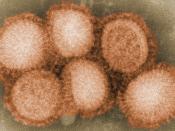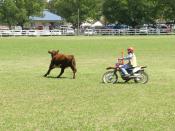Equine Influenza also known as EI or horse flu, is a viral disease found in horses (or other members of the equine species) that is highly contagious and effects the respiratory system and increases the risk of respiratory disease.
EI is a new disease to Australia and could have major consequences if it were to have spread. As Australia had never been exposed to this disease all horses were highly susceptible as they had not built up an immune defence against this strain of horse flu, however in other countries, like Japan, where this disease is established, some of the horses have built up a resistance to this disease.
This disease is purely restricted to the equine species, humans cannot catch this disease, however humans or equipment can carry and physically transfer the disease to other horses.
Cause:The cause of this disease is the subtype H3N8 of the Influenza ÃÂAÃÂ virus strain.
It is believed that this virus was introduced to Australia through 4 Japanese horses that were exposed to the EI outbreak in Japan in August 2007 at Eastern Creek Quarantine and another instance, on the same day, where some horses at Centennial Park exhibited symptoms of this disease.
Transmission:This disease is highly contagious between horses. Horses can not only be infected by the virus through direct contact, but can also become infected if they come in contact with a person or object that can carry the virus. It is therefore vital that all equipment, tack and horse floats are thoroughly sterilised and disinfected before usage, and hands need to be thoroughly washed and clothes cleaned and showers would be very effective in reducing the risk of transmitting the virus to susceptible horses.
Host Response:Once infected with this disease the susceptible horseÃÂs immune system is taken by surprise and the virus will spread quite rapidly through the body until the horse develops an effective immune response against the strain of EI. Once recovered the horse is very unlikely to suffer from EI again as it has built up a resistance against the disease.
Recovered horses are allowed to travel around Australia as they have a built up immune system that is able to destroy the virus and have a resistance as good as a vaccinated horse. As it is a Virus the damage done to the horse is intracellular. Firstly the virus invades its first host cell where it enters the cytoplasm and replicates. The host cell understands there is an infection and releases a chemical that warns other cells that it is infected, which makes the other cells produce substances that try to stop the virus replicating. This cell then can infect other cells. At this point symptoms start to become more noticeable, as the process of inflammation begins. Passing t cells encounter the infected cells and attach to them and try many methods to destroy the entire cell, and hopefully destroy the viruses increasing numbers. The t cell also releases a chemical that makes the cell kill itself, consequently killing all contained viral particles. These t cells that have developed a way to kill the virus remain in the body to be able to kill any further infection.
Major Symptoms:The main indication that a horse has the EI virus is:-A higher temperature (over 38.5 ðC)-Nasal Discharge-Depression-Appetite loss-pain in muscles-stiff muscles- Breathing is labouredTreatment:If a horse is infected with the disease, depending on its severity, the horse should be closely monitored and if symptoms persist or get worse a specialist equine veterinarian should be called. Depending on the severity one or more of the following can be implemented:-cough suppressants, to reduce pain and to reduce the risk of secondary infection-Antibiotics: if the fever and symptoms last longer than 5 days Antibiotics can be an effective treatment.
-Anti- Viral treatment, at the moment there is no Anti-viral treatment for infected horses.
Prevention:Horses that are susceptible to the virus can have a vaccination administered to prevent infection of EI. The vaccination is administered by an equine vet and can be given to any horse that has not had or does not have the disease. A recovered horse does not need the vaccination as it would be useless as the horse had already built up an effective resistance.
The vaccination is offered for free to some zones of NSW, mainly the purple zone and the red buffer zone to reduce the spread of the disease, in other zones such as the Amber or green the vaccination can be administered, however it is quite expensive.
Control:The disease was effectively controlled by the precautions, documentation and awareness by the DPI. A DPI hotline was created for people to call for information, help, current situation reports, and to register their horse as Infected, Vaccinated, Susceptible, Vulnerable or Recovered. Since the major outbreak in August 2007, many precautions and enforced restrictions have been placed upon the movement of horses around N.S.W.
Zones were created depending on the amount of reported cases and specific restrictions applied to each zone. The zones ranged in severity from purple to red to amber to green and to white. Purple being the zone with highest infection rate.
Quarantine effectiveness:The Quarantine station in Eastern Creek was able to identify and raise alarm that the virus has travelled to Australia in some Japanese horses. A few horses, on that day, in Centennial Park had also shown symptoms of the disease at the time. These horses were immediately taken to quarantine and there was a lockdown put on all horses at all events. Some horses were isolated to try to prevent further spreading of the disease. However, some people were unaware of this restriction and still travelled with their possibly infected horses and were not implementing disinfecting techniques on their equipment so the disease further spread to other horses in surrounding areas.
As the disease spread further restrictions were placed on all zones and horse movement was limited. This was aiming to prevent further spread of the disease to previously unaffected regions of Australia.
After some time horse movements in specific areas were allowed and horses could return to their home after a vet check. The horses in the green or white zone were only allowed to move within the boarders of their zone. Other states and territories were considered white zones, with very little risk of infection and no reported cases. The green zone was susceptible to the virus and almost no cases were reported. The Amber zone is where a few cases were reported and the risk of infection was plausible. The red zone was where multiple cases had been reported and was considered a high risk area; this was also known as the buffer zone and is where the majority of vaccinations were administered. The purple zone is the highest risk zone, where thousands of cases were reported and the susceptible horses were administered free vaccinations when the vaccine was available.
Once a horse was allowed to move to another property within its zone a travelling horse statement was required, this could be completed on the internet and allowed the DPI to monitor all horse movements electronically. People transporting horses without a travelling horse statement were fined. Strict enforcements monitored and patrolled all major roads for people transporting horses across boarders illegally while restrictions between boarders were in place. Any horses that were moved within the zone had a quarantine of 2 days monitored and 2 weeks isolation from other horses on both ends.
All restrictions, vaccinations, and isolation of all horses in N.S.W reduced the movement and eventually completely irradiated all instances of the virus in Australia.
Without the help of the hotline, awareness, enforcement, restrictions upon horse movement and the cooperation of all horse owners, this virus could have been a serious nationwide disease.
BIBLIOGRAPHY: (name,updated, address,accessed)The Cooperative Research Centre (CRC) for Water Quality and Treatmenthttp://www.waterquality.crc.org.au/DWFacts/DWFact_Treatment_Water.pdfDepartment of Primary IndustriesWeekly- monthlyhttp://www.dpi.nsw.gov.au/agriculture/livestock/horse/influenza/information/what-is-equine-influenzaWikipedia- EI17 May 2008http://en.wikipedia.org/wiki/2007_Australian_Equine_influenza_outbreak17/5/08Wikipedia- EI27 March 2008http://en.wikipedia.org/wiki/Influenza_A_virus17/5/08





